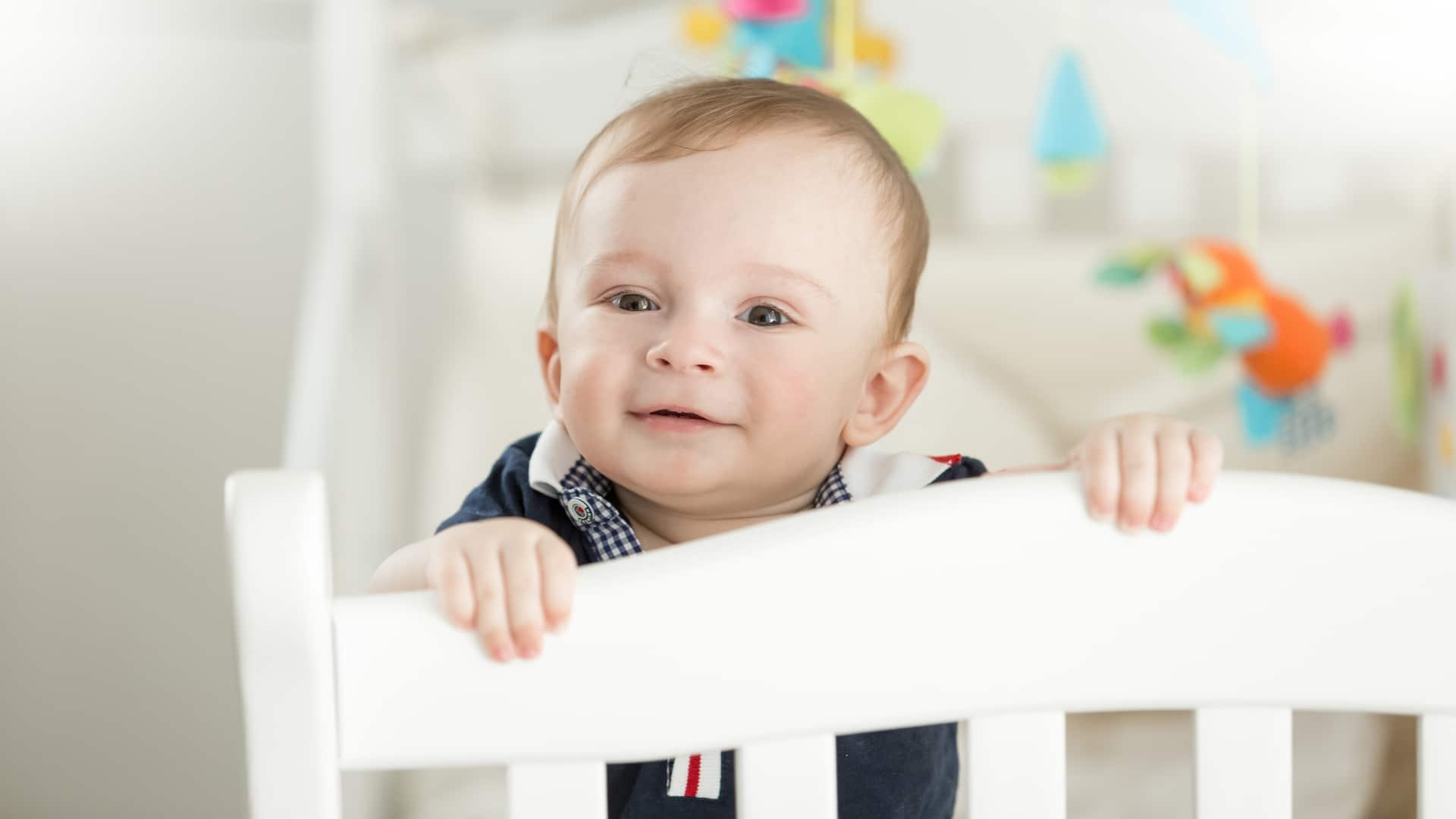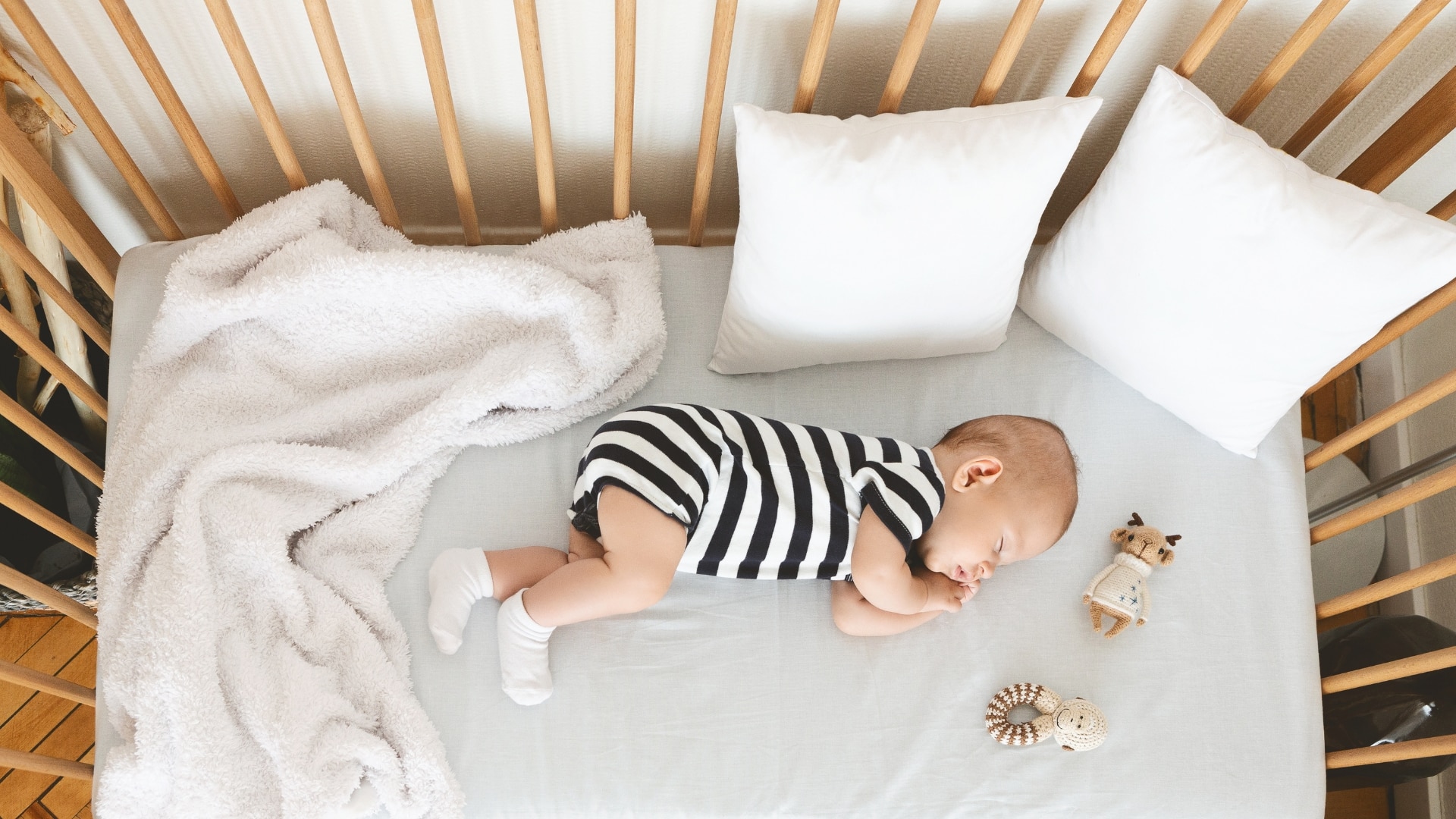The Cry It Out method of sleep training is surrounded by controversy. Some parents swear by it, others refuse to consider it.
But what’s the truth? What is the Cry It Out method? How does it work? And most importantly, what impact does it have on your baby?
With over 40 years of experience working as a Norland Nanny, I’ve helped many parents find the right sleep training method for their little ones… And now it’s time to share everything I know about the cry it out method with you.

Table of Contents
Understanding The Cry It Out Method
The Cry It Out Method (CIO) is a sleep training technique that involves leaving your baby to cry themselves to sleep without any intervention from you. It can be very hard to implement, and despite being criticized by many, it can produce remarkable sleep results.
The Cry It Out method is a controversial sleep training technique, with some experts saying it can help babies learn to self-soothe and fall asleep on their own…
And others warn of its potential to cause long-term emotional damage and undermine the parent-child bond.
It’s worth noting that there are variations of the cry it out method, including the graduated extinction sleep training method and controlled crying.
These methods involve gradually increasing the amount of time you leave your baby to cry before intervening, rather than leaving them to cry for extended periods of time all at once.
Where Do I Stand?
Personally, I am not a fan of the Cry It Out sleep training method and would never use it for young babies.
However, for older toddlers or preschoolers who are having great difficulty learning to fall asleep alone…
The Cry It Out method can be the last resort once all the other healthy habit builders and sleep training methods have been tried.
I will go into more detail about my opinion later on in this post.
Preparing Baby For Sleep Training
Before starting any sleep training method, you need to make sure you set baby up for success. The following are my key rules for establishing a healthy sleep routine that I have established over many years of experience.
They will definitely increase your chances of successful sleep training… no matter which method you opt for.
And in many cases, these tips can make sleep training unnecessary:
- Establish a consistent and calm bedtime routine. I am always talking about the importance of a bedtime routine and it’s never more important than when you’re thinking about sleep training. A regular recognizable bedtime routine should include activities that help your baby relax and wind down and happen at the same time of day so baby learns what to expect next.
- Ensure your baby is getting enough age-appropriate daytime sleep. Overtiredness at bedtime will sabotage any sleep training you attempt. You can never look at nighttime sleep in isolation so getting daytime sleep right will positively impact bedtime. To know how much sleep your little one needs, read this post from the Sleep Foundation.
- Make sure your baby’s sleep environment is conducive to sleep. Just like adults, babies have preferences when they sleep. A good place to start is to ensure your little one’s room is dimly lit, quiet, and at the right temperature. Utilise blackout blinds, white noise machines, and night lights as needed.
- Make sure your baby has been well fed during the day and before bedtime to rule out hunger causing nighttime wakings. Infants of 3 – 4 months old need about 95 kcal/kg/day and babies and toddlers aged 4 months – 3 years need 82 kcal/kg/day.
- Encourage your little one to spend time awake in their crib during the day while awake. This will help baby learn to enjoy playing alone for a short while and can be a great first step to teaching them to self-soothe.
- Get outside every day in the fresh air and natural light. Exposure to sunlight can help establish your baby’s circadian rhythm by regulating melatonin production and promoting healthy sleep patterns.
TOP TIP: Investing in a video monitor is a great idea for baby sleep training as it will allow you to check on your little one without disturbing their sleep.
How To Use The Cry It Out Method
When using a controversial method such as the cry it out method to start sleep training, it is important to look at the facts and consider your parenting style and values.
If you have decided to give the Cry It Out (CIO) method a try to help your baby self-settle and fall asleep on their own, this is how you go about it:
- First, establish a comforting and consistent bedtime routine that helps your baby feel safe and secure. This routine should include a warm bath, a lullaby, and a story.
- Next, put your baby to bed when they’re awake but drowsy, allowing them the opportunity to learn how to soothe themselves and avoid needing your presence to fall asleep.
- If your baby protests you leave them to cry themselves to sleep and do not go in to comfort them at any point. In theory, each night your baby should cry for less time until they are falling asleep independently without crying.
- Repeat for nighttime wakings and for subsequent nights until baby falls asleep without your presence.
It is important to note that for many parents leaving your baby can be extremely difficult.
While it is normal for babies to cry when they are learning to fall asleep alone, in most sleep training methods you intermittently comfort your baby to help them through this learning process.
When leaving your baby to cry for any period of time when sleep training… it can make it easier for you to use a timer to keep a focus on the amount of time you leave your baby to cry before checking on them.
This can help your baby learn to soothe themselves to sleep while also giving you peace of mind that they are safe.
This is the premise of the Ferber Method of sleep training.
REMEMBER: If you are struggling with sleepless nights and are considering the CIO method, always discuss your options with your pediatric sleep consultant first and consider other infant sleep training methods that may be better suited to your family’s needs.
Can The Cry It Out Method Be Used For Naps As Well As Bedtime?
Yes, the cry it out method can be used for naps as well as bedtime. However, it is important to establish a consistent sleep routine and stick to it to maximize the effectiveness of this method for naps.
When sleep training, ensure your little one’s naps are taken in the sleep space as their nighttime sleep to help reinforce the sleep associations too.
How Long Can Your Baby Cry It Out?
In my experience, babies are capable of crying for extended periods without stopping before falling asleep, which can be distressing for both the baby and the caregiver.
For the cry it out method, some babies will cry for 20 minutes, and others will cry non-stop for 60 minutes or more.
Remember, the cry it out method involves leaving your baby to cry for as long as it takes for your baby to fall asleep (which they eventually will) and not going in to comfort them, but it is also extremely important to listen to your instincts and respond to your baby’s needs if you feel they need you.
Looking to get your little one to sleep quickly and effortlessly? Check out my Bedtime and Nap Cheat Sheet and master the art of making daytime naps and bedtimes as seamless as possible.
A bedtime & nap cheat sheet so good your little one will ask you to put them to bed...
Laura Williams "This is a life saver! I'm so glad I downloaded your bedtime & nap cheat sheet. My little one actually asked me to put him to bed last night! Unbelievable! Thank you so much!"
Click Here For The FREE Cheat Sheet
Potential Challenges and Solutions
When considering the Cry It Out method, it’s important to be aware of the potential challenges that may arise through this sleep training technique.
Here are some common issues you may encounter and the solutions to them:
1. Tears and Temperament
Crying is a natural part of a baby’s development, and it’s normal for babies to cry when they are tired or upset.
However, some babies cry more than others, and the Cry It Out method may not be appropriate for all infants.
If your baby has a particularly sensitive temperament, they may become even more upset and distressed when left to cry alone.
Solution: Consider other gentler sleep training methods that may be more appropriate for your baby’s temperament such as the Chair Method, or Ferber Method. Talk to your pediatrician or a sleep expert for guidance.
2. Night Wakings and Illness
Babies often wake up during the night, and this can be especially challenging for parents who are trying to sleep train.
Causes of nighttime waking vary from habit, a need for comfort, inability to self-settle, sickness, or teething. Resulting in baby waking up more frequently and requiring extra comfort.
Solution: Be flexible with your sleep training approach. Consider pausing sleep training during times of illness or teething and focus on comforting your baby. Gradually resume sleep training once your baby is feeling better.
3. Comfort and Consistency
Some parents may feel uncomfortable leaving their baby to cry alone, and this can lead to inconsistency in sleep training (which is almost as bad as not doing any sleep training at all).
Additionally, some babies require a lot of comfort. This can make it difficult to stick to a sleep training method that involves leaving baby to figure out how to comfort themselves.
Solution: Consider using a sleep course or a smart sleep coach or app, to help guide you through your chosen sleep training process. These tools can provide personalized advice, and support and help you stay consistent with your approach.
4. Security and Sleep Experts
The Cry It Out method may not provide the same sense of security for some babies as other sleep training methods.
That is why some sleep experts caution against the Cry It Out method, citing concerns about potential negative effects on a baby’s emotional development.
Solution: Consider other baby sleep training methods that may be more appropriate for your little one’s needs and temperament. Talk to your pediatrician or a sleep expert for guidance on the best approach for your baby.
How Effective Is The Cry It Out Method?
The effectiveness of the cry it out method is greatly debated.
Many parenting books, including Heidi Murkoff’s “What to Expect” series, have popularized the Cry It Out method as a way to teach babies to sleep independently.
However, research shows that babies who are left to cry it out may experience increased levels of stress and anxiety, which can negatively impact their long-term emotional development.
It is also important to note that babies have different sleep needs and sleep patterns, and what works for one baby may not work for another.
Some babies may naturally sleep through the night at a young age, while others may need more time and support to develop healthy sleep habits.
When evaluating the effectiveness of the CIO method, it is important to consider factors such as sleep associations, sleepy cues, and sleep assessment.
- Sleep associations are the habits and routines that babies associate with falling asleep, such as being rocked or fed to sleep. If your baby is relying on these to fall asleep you will have greater success if you wean off these associations before attempting to sleep train.
- Sleepy cues are the signs that babies give when they are tired, such as rubbing their eyes or yawning. Reacting to sleep cues in a timely fashion can often mean that your baby will not get overtired and has a better chance of falling asleep without the need for sleep training.
- Sleep assessment involves monitoring your baby’s sleep problems and patterns and adjusting their routine as needed. Understanding your baby’s age-appropriate sleep needs and learning how and when they sleep best can also help avoid the need for drastic sleep training.
You will need to take all these things into consideration when considering whether your baby actually needs to be sleep-trained with the Cry-It-Out Method.
Ultimately, the decision to use the CIO method is a personal one that should be made with careful consideration of your baby’s individual needs and temperament.
REMEMBER: While it may be tempting to try the CIO method as a quick fix for sleep issues, it is important to prioritize your baby’s emotional well-being and safety above all else.
My Final Opinion Of The Cry It Out Method
I would always advise parents to approach the crying-out method with caution. Our job as parents and caregivers is to provide love, and comfort and make our children feel safe.
For me, the CIO method goes against those core principles and while I know how important it is for children to learn how to fall asleep independently, I feel that any sleep training has to be gentle and loving.
For your little one’s healthy development and for you to get the sleep you need, I believe that there are many other options available that can get the same results.
Establishing a sleep routine that includes a regular and recognizable bedtime routine, age-appropriate daytime sleep, and responding to sleep cues can lay strong foundations for teaching your little one to self-settle and will give any sleep training you may try a better chance of success.
I have to admit that I have never used the CIO method as I have always managed to help young babies and toddlers fall asleep independently in a supportive, gentle, and loving way before requiring its use.
It is also worth mentioning that it is not a foregone conclusion that you will need to or even want to sleep train.
Some parents are more than happy to rock their children to sleep and/or be up several times a night knowing that there will naturally come a time when they will all get a good night’s sleep.
No matter what it is, if it’s working for you then don’t feel pressured to change it.
However, if your little one’s inability to self-settle and sleep through the night is disrupting family life or causing you great stress, then some form of sleep training may definitely be the answer.
The following is a very in-depth article about the pros and cons of sleep training and safe sleep and talks a lot about the CIO method if you’d like to learn more: How Sleep Training Affects Babies.
Frequently Asked Questions About The Cry It Out Method
Looking for more information about the cry it out method of sleep training? Here are the most frequently asked questions answered just for you.
Q: What is the recommended age to start the cry it out method?
A: The American Academy of Pediatrics does not recommend any form of sleep training before 6 months of age. However, some supporters of the cry it out method suggest starting as early as 4 months old… which, in my opinion, is far too young. It is important to consult with your pediatrician before beginning any sleep training method, especially the CIO method.
Q: How long should I let my baby cry it out?
A: The cry it out method involves leaving your baby to cry until they fall asleep and not intervening unless it is an emergency. This can be anywhere between 15 and 60+ minutes long.
Q: How long should you let a newborn cry?
A: You should never let a newborn cry for an extended period of time. It is unnecessary and harmful to them. You should not be using the cry-it-out method on newborn babies. If you are struggling to look after your newborn, seek help from friends and family or contact your local doctor.
Q: Are there any potential psychological effects of letting a baby cry it out?
A: There is some evidence to suggest that allowing a baby to cry it out can lead to increased levels of cortisol, a stress hormone. This can potentially have negative effects on a baby’s developing brain. However, more research is needed to fully understand the long-term effects of this method.
Need More Parenting Help?
- Download our FREE Bedtime & Nap Sleep Cheat Sheet. It’s a free, easy-to-use and proven formula designed for parents of 0-5 year olds to master the art of consistently undisturbed and restful sleep without the yelling, nagging or exhausting long-winded evenings.
- Check out our Parenting Toolbox. You’ll get access to expertly-chosen products that you can guarantee are the best for your little one and your wallet.
- Are you looking for personalized guidance to navigate the challenges of parenting? I offer 1-on-1 consultations to bring you tailored strategies and actionable advice to help support your child's growth and well-being with confidence.

A bedtime & nap cheat sheet so good your little one will ask you to put them to bed...
Laura Williams "This is a life saver! I'm so glad I downloaded your bedtime & nap cheat sheet. My little one actually asked me to put him to bed last night! Unbelievable! Thank you so much!"
Click Here For The FREE Cheat Sheet


